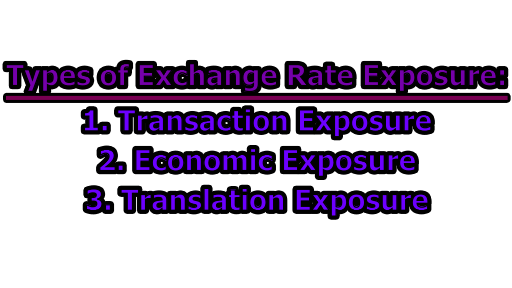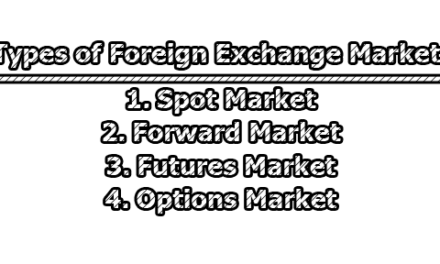Exchange rate Exposer is the uncertainty created by the unintuitive movement in the exchange rates between the currencies. Exchange rate exposure can be broadly defined as the risk that a company’s performance will be affected by exchange rate movements. Financial managers must understand how to measure the exposure of their MNCs to exchange rate fluctuation so that they can determine whether and how to protect their companies from that exposure. In the rest of this article, we are going to present types of exchange rate exposure.
Types of Exchange Rate Exposure:
Although exchange rates cannot be forecasted with perfect accuracy, firms can at least measure their exposure to exchange rate fluctuations. The firm should first measure its degree of exposure. Exposure to exchange rate fluctuations comes in three forms:
1. Transaction Exposure: The degree to which the value of future cash transactions can be affected by exchange rate fluctuations is referred to as transaction exposure. The value of a firm’s future contractual transactions in foreign currencies is affected by exchange rate movements. The sensitivity of the firm’s contractual transactions in foreign currencies to exchange rate movements is referred to as transaction exposure.
Transaction exposure can have a substantial impact on a firm’s value. It is not unusual for a currency to change by as much as 10 percent in a given year. If an exporter denominates its exports in a foreign currency, a 10 percent decline in that currency will reduce the dollar value of its receivables by 10 percent. This effect could possibly eliminate any profits from exporting.
Example (Point estimation):
| Currency | Total Inflows | Total Outflows | Expected Exchange Rate |
| £ | £ 10 million | £ 8 million | $ 1.50 |
| C$ | C$ 8 million | C$ 10 million | $ 0.80 |
| ¥ | ¥ 100 million | ¥ 50 million | $ 0.01 |
Requirements: Estimate the net cash flows, in an exposure.
Solution:
| Currency | Total Inflows | Total Outflows | Net Flows | Expected ER | Net Flows in US $ |
| £ | £ 10 million | £ 8 million | £ 2 million | $ 1.50 | $ 3 million |
| C$ | C$ 8 million | C$ 10 million | (C$ 2 million) | $ 0.80 | ($ 1.60 million) |
| ¥ | ¥ 100 million | ¥ 50 million | ¥ 50 million | $ 0.01 | $ 0.5 million |
| Total | $ 1.9 million | ||||
So, a total of $ 1.9 million of future cash transactions is in exchange rate exposure.
2. Economic Exposure: Economic exposure is the risk that a company’s cash flow, foreign investments, and earnings may suffer as a result of fluctuating foreign currency exchange rates. The value of a firm’s cash flows can be affected by exchange rate movements if — it executes transactions in foreign currencies, receives revenue from a foreign subsidiary, or is subject to foreign competition.
The sensitivity of the firm’s cash flows to exchange rate movements is referred to as economic exposure. Transaction exposure is a subset of economic exposure. But economic exposure also includes other ways in which a firm’s cash flows can be affected by exchange rate movements.
Example: Intel invoices about 65 percent of its chip exports in U.S. dollars. If the euro weakens against the dollar, the European importers of those chips from Intel will need more euros to pay for them. As their costs of importing the chips increase in response to the weak euro, they may decide to purchase chips from European manufacturers instead. Consequently, Intel’s cash flows from its exports will be reduced.
3. Translation Exposure: The risk of loss that might arise due to changes in the value of the stock, revenue, assets, or liabilities of a business due to foreign exchange rate movements. A business has translation exposure when some of its stock, revenue, assets, or liabilities are denominated in a foreign currency and need to be translated back to its base currency for accounting purposes.
An MNC creates its financial statements by consolidating all of its individual subsidiaries’ financial statements. A subsidiary’s financial statement is normally measured in its local currency. To be consolidated, each subsidiary’s financial statement must be translated into the currency of the MNC’s parent.
Since exchange rates change over time, the translation of the subsidiary’s financial statement into a different currency is affected by exchange rate movements. The exposure of the MNC’s consolidated financial statements to exchange rate fluctuations is known as translation exposure.
The proportion of Its Business Conducted by Foreign Subsidiaries: The greater the percentage of an MNC’s business conducted by its foreign subsidiaries, the larger the percentage of a given financial statement item that is susceptible to translation exposure.
Determinants of Translation Exposure: An MNC’s degree of translation exposure is dependent on the following:
- A proportion of its business is conducted by foreign subsidiaries.
- The locations of its foreign subsidiaries.
- The accounting methods that it uses.
The translated earnings for each reporting period in U.S. dollars are determined as follows:
| Reporting period
|
Local Earnings of British Subsidiary
|
Exchange rate of the pound over the reporting period
|
Translated US dollar earnings of British subsidiary |
| Year 1 | £10,000,000 | $1.70 | $17,000,000 |
| Year 2 | £10,000,000 | $1.50 | $15,000,000 |
Notice that even though the subsidiary’s earnings in pounds were the same each year, the translated consolidated dollar earnings were reduced by $2 million in year 2. The discrepancy here is due to the change in the British pound exchange rate. The drop in earnings is not the fault of the subsidiary but rather of the weakened British pound that makes its year 2 earnings look small (when measured in U.S. dollars).
References:
- Allayannis, G. & Weston, J.P., 2001. The use of foreign currency derivatives and firm market value. The Review of Financial Studies, 14(1), pp.243-276.
- Bartov, E. & Bodnar, G.M., 1994. Firm valuation, earnings expectations, and the exchange-rate exposure effect. The Journal of Finance, 49(5), p.1755.
- Booth, L. & Rotenberg, W., 1990. Assessing foreign exchange exposure: theory and application using Canadian firms. Journal of International Financial Management & Accounting, 2.

Assistant Teacher at Zinzira Pir Mohammad Pilot School and College










